Embarking on a roadschooling journey transforms the world into a dynamic classroom filled with endless learning opportunities and unforgettable adventures.
Homeschooling on the road has been a transformative journey for my family and me, blending education with the thrill of discovery.
As an experienced semi-budget traveler and dedicated travel planner, I have spent years refining the perfect balance between cost-effective travel and enriching educational experiences.
Through meticulous planning and countless adventures, I’ve gained valuable insights into making roadschooling both feasible and enjoyable.
Join me as I share tested strategies, insightful tips, and personal anecdotes, ensuring your roadschooling journey is both memorable and fruitful.
SBT Highlights
- Homeschooling on the road turns travel into educational adventures.
- Equipping your mobile classroom with diverse resources is essential.
- Integrating technology helps balance traditional and modern education.
HI THERE! DON’T FORGET TO PIN THIS FOR LATER!
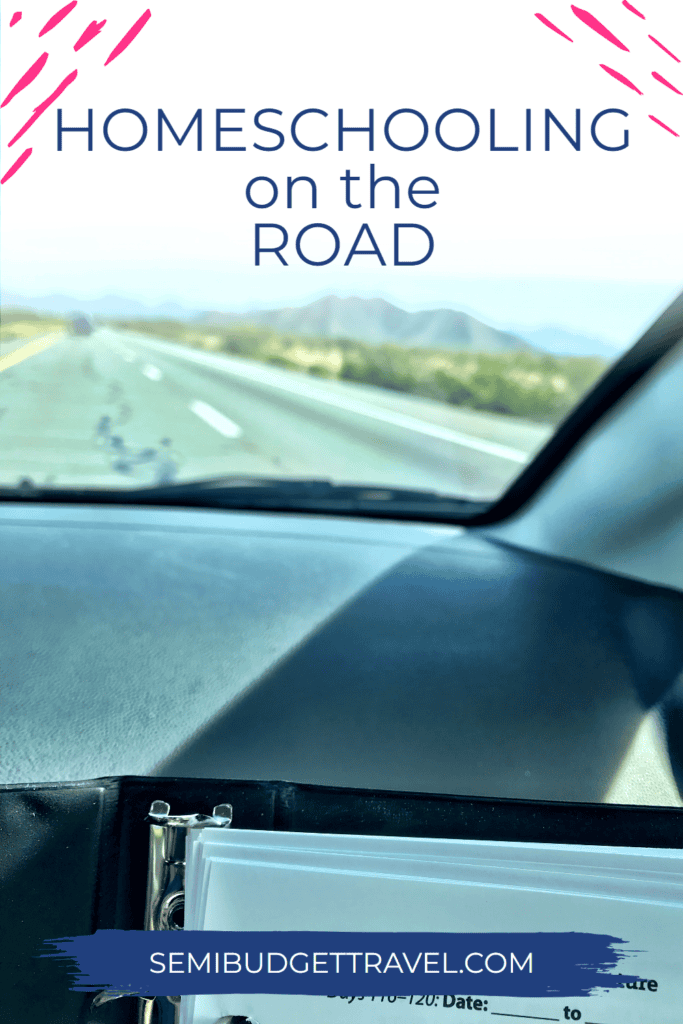
- Homeschooling on the Road
- Embarking on the Journey: What Is Roadschooling?
- Setting Up Your Classroom on Wheels
- Cultivating a Roadschooling Lifestyle
- Enrichment Through Exploration
- Integrating Technology and Travel
- Blending Traditional and Modern Education
- Maintaining Motivation and Focus
- Documenting the Adventure
- Overcoming Challenges: Tips and Tricks
- Benefits of Homeschooling on the Road
- Our Experience Roadschooling to Arizona
- Frequently Asked Questions
- SBT Summary: Homeschooling on the Road
Homeschooling on the Road
Have you ever thought about taking your child’s education on the road? Imagine combining the joys of family travel with a world-class learning experience.
Homeschooling on the road allows your family to turn every journey into an educational adventure. You’ll find that the world truly becomes your classroom, providing opportunities to learn from real-world experiences and historical sites that bring textbooks to life.
Setting up your mobile classroom is simpler than you might think.
Equip your mode of transportation with a variety of educational resources, from math and language arts to science and history.
The flexibility of roadschooling enables you to swap out traditional lessons for hands-on experiences, such as exploring National Parks or visiting museums, which can enrich your child’s learning journey.
Integrating technology into your roadschool routine can keep your child connected to the broader educational world.
With a stable internet connection, online resources, and interactive learning tools, you can create a balanced mix of traditional and modern education that suits your family’s unique needs.
This way, you can maintain motivation and focus while embracing the freedom of the open road.
Embarking on the Journey: What Is Roadschooling?
Welcome to the adventurous world of roadschooling! Imagine teaching your kids while traveling, exploring new places, and diving headfirst into hands-on learning experiences.
Roadschooling 101: The Essentials
Roadschooling combines homeschooling with travel, offering a unique educational adventure. Your family hits the road, turning every new place into a classroom.
Lessons range from traditional subjects like math and science to practical skills learned during travels.
Essential supplies include a reliable vehicle, a curriculum flexible enough for travel, and internet access for research and assignments.
A blend of book work and adventure studies often suits roadschoolers best.
Flexibility and creativity are key—you’ll need both to keep learning consistent and engaging.
I am not an attorney, so I am not providing legal advice, but I am a long-time travel & homeschool mom. I encourage you to do your own research and come to your own conclusions as to what’s best for your family!
Legal Landscape: Understanding Homeschool Laws
Homeschooling laws vary by state, so it’s crucial to know the regulations of your home state before you start roadschooling.
Each state has its own laws regarding homeschooling, so research is vital. Each state has different requirements.
Stay informed and prepared to avoid any legal issues. Connecting with local homeschooling groups can offer valuable insights and support.
Realities of Mixing Travel with Education
Traveling with your family while ensuring a quality education takes effort and organization.
It’s not all sightseeing and adventure—you’ll need to balance fun activities with structured educational time.
Experiential learning is a big part of roadschooling, but dedicated study sessions are also necessary.
You’ll need to adapt to different environments, whether it’s setting up a mobile classroom in a park or utilizing Wi-Fi in a coffee shop.
Communication and collaboration among family members are crucial.
It might be challenging at times, but the personal growth and unique experiences make it worthwhile.
Setting Up Your Classroom on Wheels
Organizing a homeschooling setup in a vehicle may seem daunting, but with the right curriculum and resources, it can be a rewarding experience. Let’s explore how to choose a curriculum, find online and offline resources, and create an organized learning space.
Choosing Your Curriculum
Choosing the right homeschool curriculum is essential. Consider your child’s learning style and grade level.
Some families stick to a traditional curriculum, while others prefer a more flexible approach.
Don’t forget to account for travel experiences as part of your curriculum. You might find that visiting historical sites or national parks offers valuable learning opportunities that can’t be found in textbooks.
Balance formal school work with hands-on learning for a comprehensive education.
Online and Offline Resources
You have a wealth of online resources at your fingertips.
Many websites offer free courses across various subjects. Subscription services can provide structured lessons and practice.
Offline resources are equally important.
Utilize your local library whenever you’re at a home base or near a town. Libraries often lend out books, DVDs, and educational kits.
Incorporating both online learning and offline materials can create a well-rounded educational environment for your child.
Creating an Organized Learning Space
Transforming your mode of transportation into a classroom might require some creativity.
Keep supplies like notebooks, pens, and art materials stored in organizers to prevent clutter.
Cultivating a Roadschooling Lifestyle
Creating a roadschooling lifestyle involves weaving travel into your child’s education and fostering independence and responsibility. This approach can help them learn effectively while enjoying a fulfilling travel lifestyle.
Incorporating Travel into Lesson Plans
Travel provides endless opportunities for learning. Use the places you visit to teach subjects like history, science, and geography.
For example, a visit to Yellowstone National Park can cover ecology, geology, and wildlife studies.
You can find many ideas for roadschooling activities that make learning fun and relevant.
Field trips become daily adventures. Imagine your child learning about American history while exploring national landmarks or understanding marine biology on a beach trip.
Connect lessons with real-world experiences to make concepts stick. A rich curriculum can fit in a backpack, allowing you to combine book learning and real-life exploration.
Fostering Independence and Responsibility
Learning on the road teaches children to be self-reliant. They learn to manage their own tasks and schedules, which fosters independence.
Assigning chores like helping with travel planning can build responsibility.
You can encourage your children to track travel routes or make grocery lists, integrating math and planning skills.
Kids also learn flexibility and problem-solving as they adapt to new environments. They gain confidence navigating these challenges, which is crucial for personal growth.
The roadschooling lifestyle naturally supports independence, helping your kids become capable and responsible individuals.
Enrichment Through Exploration
Traveling while homeschooling opens the door to countless hands-on learning opportunities. This approach broadens your family’s education scope through interactive field trips and cultural experiences.
Interactive Field Trips: More Than Just Fun
Field trips are not just a fun break from regular studies; they are powerful educational tools.
Visiting historic sites like Gettysburg lets your kids walk through history and see where key events took place. State parks offer unique experiential learning opportunities where children can explore nature, geology, and conservation.
If you’re at a site with a Junior Ranger Program, your children can earn badges while learning about the environment.
Such hands-on activities make lessons stick much better than textbooks alone.
Incorporating real-world experiences into your homeschooling routine helps reinforce academics with vivid, real-life memories.
Learning from Different Cultures
One of the greatest benefits of homeschooling on the road is the chance to learn from various cultures.
Exploring different cultures up close teaches your children to appreciate diversity and understand global perspectives.
Dining at local restaurants exposes your family to new foods and traditions. Attending cultural festivals provides an immersive experience in different ways of life.
By visiting places with rich cultural histories, such as Native American heritage sites, your children gain insights that go beyond what they’d learn from a book.
Utilizing these travel experiences helps develop well-rounded, culturally aware individuals ready to engage with the world.
Integrating Technology and Travel
Integrating technology into your roadschooling routine can make lessons more dynamic and interactive. From utilizing digital tools for learning to tapping into online resources, you can create an enriching educational experience while on the go.
Voice Amplifier
Yes, seriously.
Using a voice amplifier can be a game-changer, especially when teaching in noisy environments like a car going freeway speeds with the A/C on full blast.
A portable voice amplifier ensures everyone hears you clearly during lessons.
Investing in a quality device can save your voice and keep kids engaged.
It’s also garnered lots of laughs over the years.
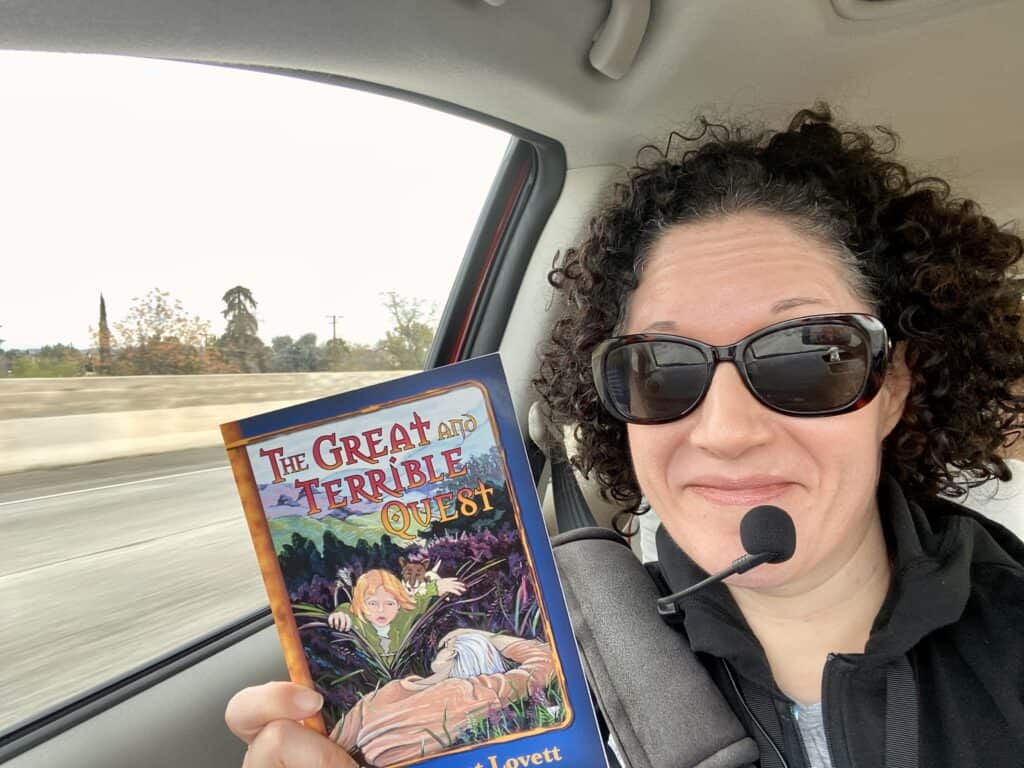
Voice Amplifier!
Effortlessly amplify your voice with this lightweight, portable voice amplifier, perfect for clear and powerful sound, whether you’re teaching, guiding tours, or reading in the car, of course!
Leveraging Online Learning Platforms
Online learning platforms are your new best friends.
Again, many websites offer free courses covering various subjects. These platforms provide structured lessons, interactive exercises, and even assessments.
Distance education programs also offer various curricula suited for different learning styles.
Enroll your kids in live classes, or download materials for offline study during long drives.
By leveraging platforms, you can fill the gap that traditional public or private schools might leave behind, providing a comprehensive education regardless of your location.
Educational Podcasts and YouTube on the Go
Podcasts and YouTube videos make learning fun and flexible.
Educational podcasts can cover a range of topics like science, history, or literature.
Turn mundane road trips into fascinating journeys by listening to interesting stories or facts.
YouTube is another treasure trove. Channels like TED-Ed offer short, engaging videos perfect for visual learners.
Download videos ahead when you have Wi-Fi, so you’re never without educational content.
Using these resources, you can blend entertainment with education seamlessly while traveling.
Blending Traditional and Modern Education
Blending traditional education with modern roadschooling methods allows flexibility while maintaining structure. It’s about mixing the best of both worlds: classic curriculum and real-world learning adventures.
Combining Roadschooling with Traditional Schooling
You don’t have to choose between traditional schools and roadschooling. It’s possible to integrate both for a well-rounded education.
For instance, you might use a traditional curriculum for core subjects like math and language arts.
These subjects provide a solid foundation that’s essential for educational development.
At the same time, you can embrace the unique opportunities roadschooling provides.
While traveling, visit museums, historic sites, and cultural landmarks.
This approach helps kids connect theoretical knowledge with real-world experiences. Field trips become rich learning environments where history and science come alive, making education more engaging.
Traveling homeschoolers benefit from combining structured learning routines with the spontaneity of travel. This hybrid approach ensures your kids are prepared academically while also gaining a broader perspective on the world.
Balancing Structure with Flexibility
Achieving the right balance between structure and flexibility is key.
As a homeschooling mom, you might set aside specific times each day for formal studying. This includes sticking to a school year schedule to keep on track with academic goals.
Yet, be flexible enough to let learning opportunities guide your schedule.
For example, if you stumble upon a fascinating museum or a natural wonder, don’t hesitate to spend extra time exploring. These experiences can be just as valuable as any textbook lesson.
Incorporate art classes, writing sessions, or building projects into your routine.
Set up mini-schedules that outline daily tasks but allow room for spontaneous adventures.
Blending fixed lessons with flexible exploration helps maintain educational standards without missing out on the unique aspects of roadschooling.
This way, you prepare your kids for future academic demands while enriching their lives with diverse experiences.
Maintaining Motivation and Focus
Keeping your kid motivated and focused while roadschooling can be a full-time job.
You need to engage their sense of curiosity and set realistic goals tailored to their individual needs.
Let’s explore two key strategies to keep them motivated and on track.
Encouraging Self-Directed Learning
Kids love to explore and learn about things that truly interest them.
Giving your child some control over what they study can make a big difference in their enthusiasm.
You can set aside flexible blocks of time each day for them to choose their own projects or readings.
Build units around the places you travel.
For example, if you’re in Arizona, let them learn about the Grand Canyon’s geology.
Provide diverse materials like books, apps, and documentaries.
Involve your child in decisions.
Ask for their input on what they want to study next.
This approach makes school work feel less like a chore and more like an adventure. It also builds critical life skills like decision-making.
Setting Achievable Goals for Students
Set clear, achievable goals for your child. This approach helps them see their progress and feel a sense of accomplishment.
Use weekly or even daily goals rather than long-term ones to keep things manageable and less overwhelming.
For instance, if your child struggles with math, set a goal of completing three problems correctly instead of an entire worksheet.
Celebrate these small victories to boost their confidence.
Incorporate rewards that match your child’s interests.
Keep track of their progress in a journal or on a chart to make achievements visible.
This method boosts their motivation to complete school work and stay focused.
Documenting the Adventure
Documenting your travels while homeschooling on the road can be a thrilling part of the journey. It not only preserves memories but also shares your unique experiences with others.
Starting a Travel Blog or Vlog
Creating a travel blog or vlog can be a fun way to document all the exciting places you visit.
A blog lets you chronicle daily activities, favorite places, and lessons learned.
You can even include a video vlog to capture live reactions and scenery.
Platforms like WordPress or YouTube are great for getting started.
Share travel plans, tips, and reviews of places you visit.
Engage with your audience by responding to comments and questions.
This not only provides a virtual diary but also connects you with a community of fellow travelers.
Capturing Memories and Milestones
While on the road, it’s important to capture those special moments.
Keep a scrapbook or digital album with pictures.
Collect mementos from various landmarks in the United States.
Whether it’s a photo of a stunning sunset or a picture of your child reaching a milestone, these memories are priceless.
Besides photos, jot down notes about your kids’ achievements and daily experiences.
Apps like Evernote can help keep everything organized.
You’ll cherish these snapshots of your life on the road and have a beautiful record to look back on.
Often, it’s the small moments and unique local experiences that will stand out the most!
Overcoming Challenges: Tips and Tricks
Navigating homeschooling on the road can be a unique opportunity but comes with its own set of challenges. From managing expenses to coping with unpredictability, here’s how you can make your journey smoother.
Budgeting for Travel
Traveling and homeschooling don’t have to break the bank. A great way to save money is by planning ahead.
Creating a detailed budget for fuel, food, and lodging will help you stay on track.
Look for discounts or use loyalty programs for frequent stays.
Stock up on groceries and cook your own meals, instead of dining out can save much money.
Consider financial apps to monitor your spending.
This will help you see where your money goes and adjust your budget as needed.
Managing Stress and Uncertainty
Stress and uncertainty are inevitable, but they don’t have to overwhelm you.
Being flexible with your homeschooling curriculum can help reduce pressure.
When unexpected events happen, take a deep breath and adjust your plans.
Embrace the unpredictability as part of the learning experience.
Establish a routine that fits your travel schedule. This can provide stability and reassurance.
Ensure that you incorporate downtime for both you and your children to relax.
Connect with other traveling homeschool families for support and shared advice.
Stay adaptable and remember that every challenge met is a learning opportunity.
Benefits of Homeschooling on the Road
Are you ready to homeschool on the road?
You’re not alone!
Homeschooling is becoming increasingly popular and homeschooling on the road offers a unique opportunity to combine education and travel. There are some great benefits to homeschooling while traveling!
Educational Opportunities
Travelling opens the doors to a world of learning opportunities.
By homeschooling on the road, you can visit historical sites and monuments in person, explore local cultures and languages, and make connections with people from different parts of the country or even from around the world.
These experiences create an educational foundation that goes far beyond what is taught in textbooks.
Field trips are also a great homeschooling opportunity on the road.
Whether you are visiting an art museum or researching the local ecology, homeschoolers can take advantage of the location-based educational opportunities that arise during travel.
How many public school field trips took me to national parks? None!
Family Bonding
Spending time together as a family is an important part of homeschooling on the road.
Traveling to different destinations allows your children and yourself to share unique experiences, learn more about each other, and continue to grow closer as you explore new places.
Cost Savings
Since homeschooling on the road allows you to combine travel and homeschooling into one, it can end up being more cost effective in the long run.
Instead of paying for separate homeschool materials and travel expenses, roadschooling allows you to save money by combining them into one.
Flexibility
Homeschooling on the road gives families a lot of flexibility when it comes to scheduling and curriculum.
You can plan and adjust as you go, allowing for more exploration and down time.
With homeschooling on the road, you have the opportunity to slow down or speed up depending on your child’s interests and abilities.
It can also help you save lots of money by being able to travel during off-peak times of the year!
No Internet Connection Needed
Although I’ve mentioned the use of technology, it’s important to note that not all learning has to be done online.
In fact, some of the most valuable lessons can come from hands-on experiences and exploring new places.
Homeschooling on the road allows for a balance between using technology and disconnecting from it.
You can homeschool in remote areas or places where there isn’t good WiFi, allowing for more exploration and less reliance on technology.
Our Experience Roadschooling to Arizona
Roadschooling to Arizona has become somewhat of an annual tradition. Our family thrives on the flexibility that homeschooling affords, and winter is a great time to visit extended family in Arizona.
December, January, February, March, and April are usually nice times to visit the state of Arizona. May, June, July, August…not as much. I know. I used to live there!
We especially love the ability to travel during non-peak times, while most schools are in session.
We’re just one of those traveling families…not full time travelers, but we like to travel as much as we can.
While we do enjoy actual breaks from both work and school, many of our trips allow us to keep up with homeschool in some way or another.
For us, however, the best kind of trip for homeschool on the go is a good ol’ road trip!
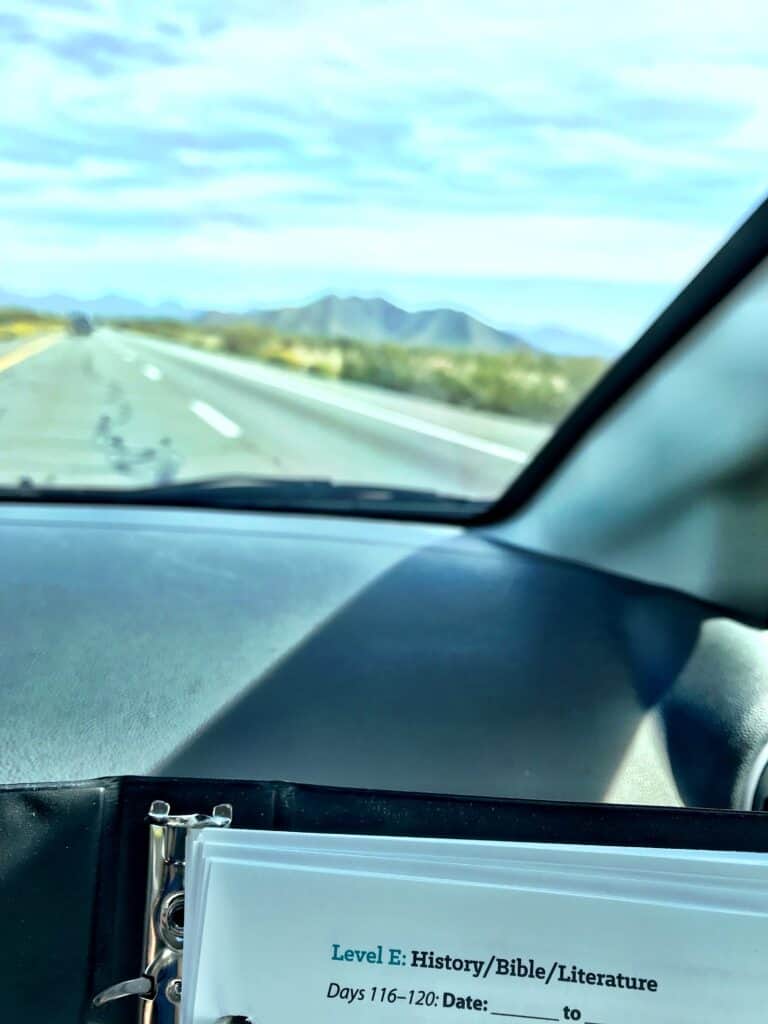
The Books & Supplies!
Is this true for you? It’s much easier to pack for a road trip than for an airplane trip. You just don’t need to economize on space quite as much.
Even still, we took an entire carry-on full of school stuff to Hawaii, and some language arts readers came with us to Iceland.
For roadschooling to Arizona, however, we brought just about everything, other than the science experiment kits. And it all fit into two small tote bags!
The best roadschooling curriculum is Sonlight! Here’s the indoor homeschool setup (once we reached Arizona). Notice that one of my children is using the tote bag on the right as a bookmark!

The Sonlight Instructor’s Guide (IG) pages that we needed for the trip fit neatly into a small 3-ring binder, along with science and language arts activity sheets. It’s so easy to pull out the IG pages, as well as the read-aloud and reader questions, and go!
Loose-leaf math papers and small workbooks go right into these plastic zipper pouches. I use a smaller plastic pouch for pens and pencils.
Clipboards complete our list of supplies for roadschooling. The kind we have even has a ruler in inches down one side and a ruler in centimeters down the other side, so it even helps with math lessons! Super simple!

The Road Trip!: Roadschooling to Arizona
Do we actually homeschool in the car? You bet we do!
Roadschooling to Arizona actually allows us to get multiple days of school done in just one day of driving! And the only way this is possible is because we use Sonlight Curriculum.
I make sure to have my water bottle close by, and I read, read, read.
A major game-changer for reading in the car has been my voice amplifier!!!!!
What’s really fun is seeing my husband react to the books as he’s driving. Usually, we’re halfway through a novel already when the road trip begins. Even without the backstory, the hubs gets into the story, and he enjoys it right along with us.
The kids can even get some of their own reading done, when it’s time for a short break in read-alouds.
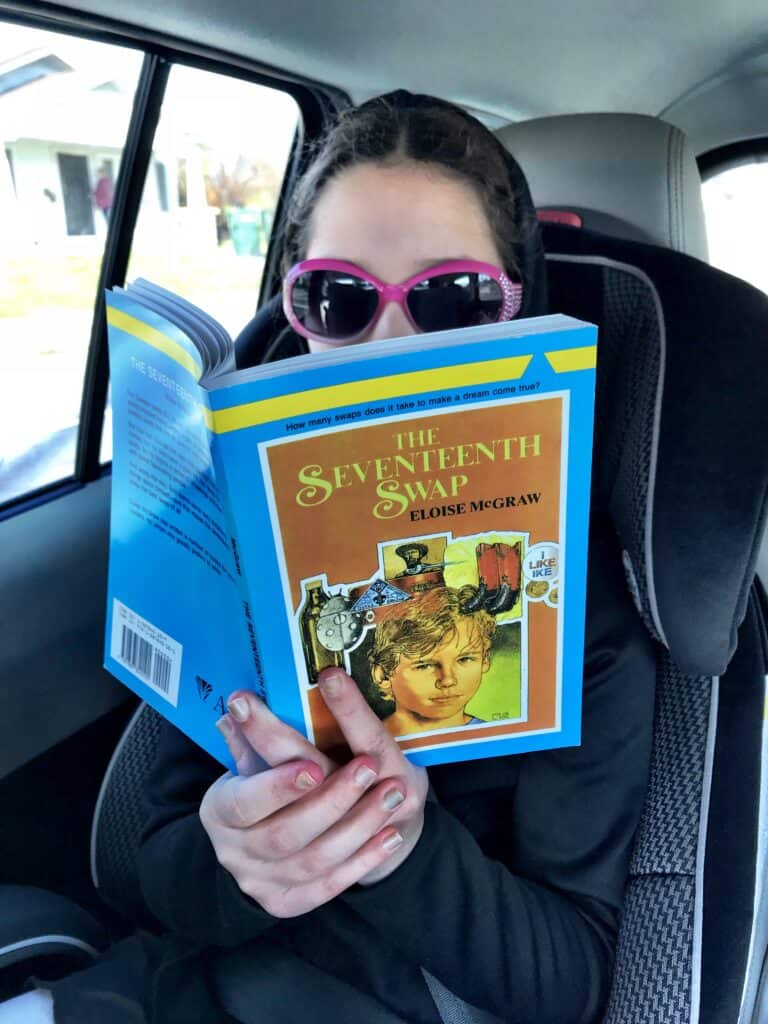
The Snow Day!
Somewhat unexpectedly (we did know it would be chilly), it snowed in Tucson, Arizona! As rare as that is, this was actually the third time in six consecutive years that it’s snowed in Tucson during our annual trip to The Old Pueblo. That’s a pretty impressive record!
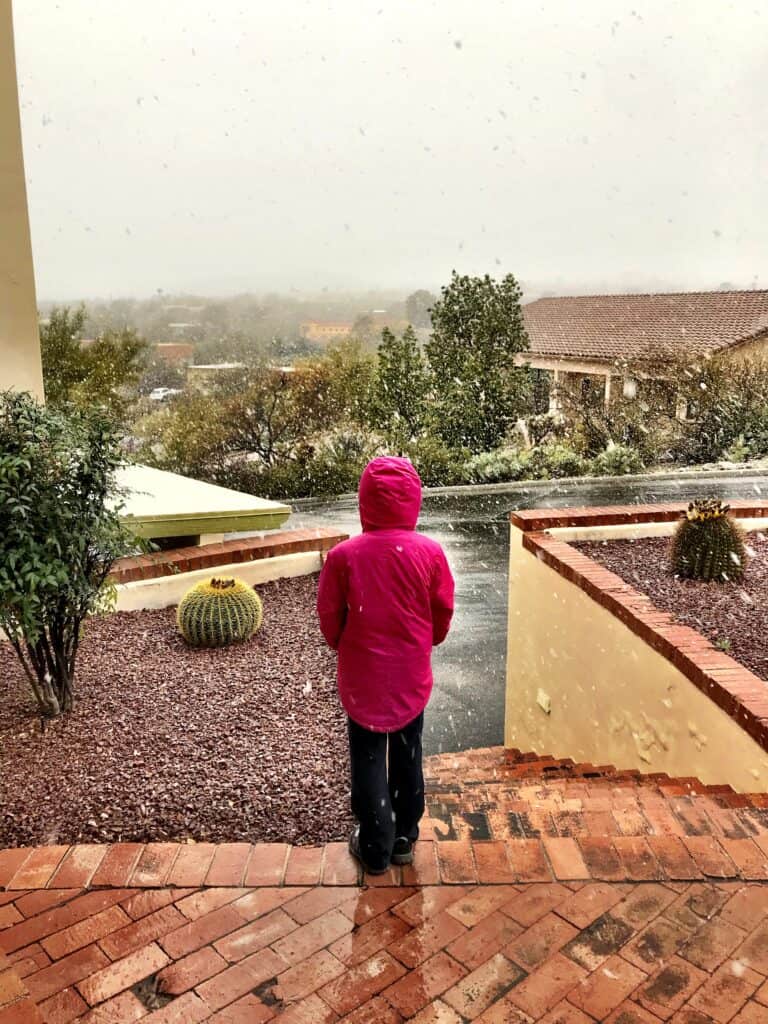
This was just the beginning. I actually drove to breakfast in whiteout conditions…well, Tucson-level whiteout conditions, that is…which was still some serious snowfall. It was quite an experience! Have you ever been excited about snow (like us SoCal-ians)?????
Because of the snow, however, outdoor activities (playground, park, outdoor attractions) weren’t possible. More homeschooling was possible though!
This room is so nostalgic to me. I spent many a Thanksgiving and Christmas in this house. We’ve done school in this room several times now, and I just love it!
Sonlight books and activity sheets are what make it possible! We’re ready for more homeschool travel! On to the next road trip!
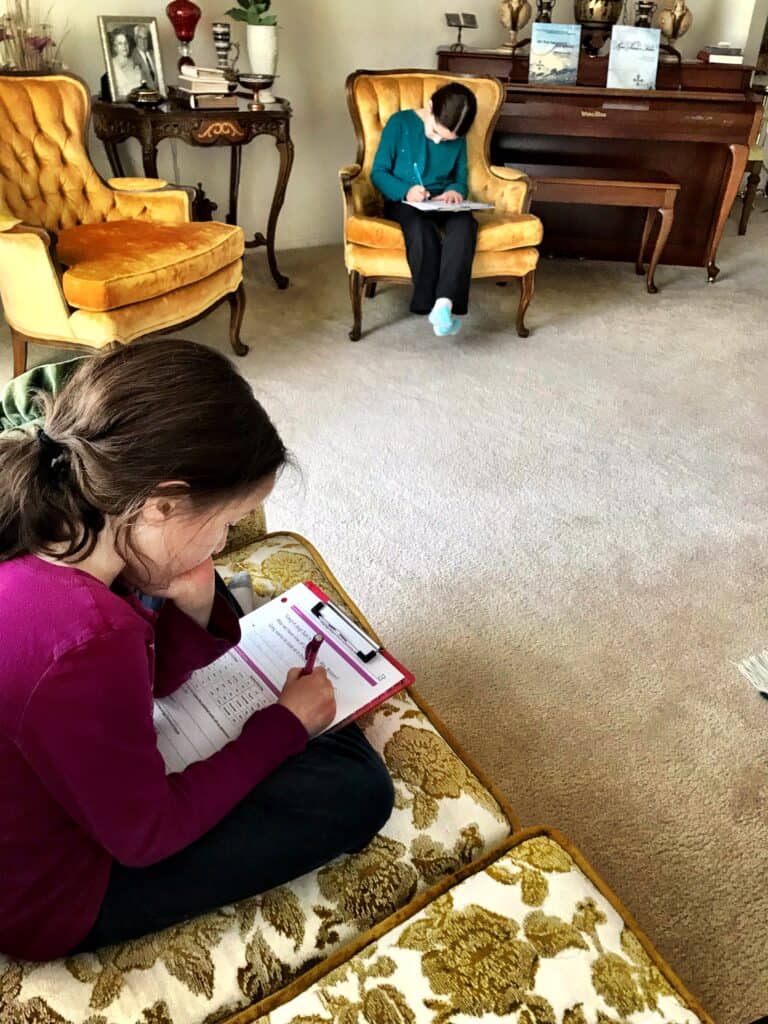
Frequently Asked Questions
Balancing travel and education while roadschooling can be tricky but doable with the right strategies. Keeping children engaged and ensuring they receive a well-rounded education are key to successful roadschooling.
Do I have to travel full-time to be homeschooling on the road?
Definitely not! Roadschooling is all about incorporating travel and real-life experiences into your child’s education. It can be done on a full-time or part-time basis, depending on your family’s preferences and lifestyle.
What are the best strategies for balancing travel and education while roadschooling?
Mix learning with your travel plans. Visit museums, historical sites, and national parks.
Use these trips as real-life lessons in history, science, and geography.
Plan your travel routes around educational stops to keep learning fun and immersive.
Set a flexible but consistent schedule.
Keeping some structure helps kids know when it’s time to learn and when it’s time to explore.
What tips can you share for keeping children engaged in lessons while on a long road trip?
Incorporate games and interactive activities.
Educational travel apps and audiobooks are great for making lessons fun.
Use the scenery outside your window to talk about the different landscapes, wildlife, and landmarks you pass by.
Make it hands-on by using travel kits with drawing or writing supplies.
Encourage kids to keep travel journals to document what they learn and see.
How do I ensure my road-taught scholars get a well-rounded education?
Combine traditional subjects with unique travel learning experiences.
Use online resources for core subjects like math, language arts, and science.
Supplement your lessons with activities tied to your travels.
Visit science centers for biology lessons, or historical sites for history classes.
Make every stop a chance to learn something new.
What kind of curriculum is most adaptable for a family that’s always on the go?
Look for portable and flexible curricula.
Digital curriculum can be accessed from anywhere with an internet connection.
Roadschooling families often use a mix of online programs, ebooks, and travel-friendly materials.
Consider curricula that focus on experiential learning.
These allow you to blend book work with hands-on activities that tie into your travels. This approach keeps learning engaging and adaptable.
SBT Summary: Homeschooling on the Road
Homeschooling on the road offers a unique blend of education and adventure. You can visit places and engage in activities that traditional students only read about.
Key Benefits:
- Flexibility: Create your own schedule to fit your family’s lifestyle.
- Real-world Learning: History, geography, and science come to life as you travel.
- Quality Time: More opportunities to bond as a family while learning.
Tips for Successful Roadschooling
- Curriculum: Choose materials that cater to your child’s learning style. Options include online courses, textbooks, and hands-on activities.
- Scheduling: Balance schoolwork with travel.
- Activities: Hiking, visiting museums, and cultural experiences turn every trip into an educational adventure.
What to Include in Your Travel Pack
- Essentials: Books, notebooks, and portable devices.
- Extras: Educational games and science kits.
Remember, the goal is to make learning fun and engaging while still covering the basics.
Homeschooling on the road is an opportunity to make life-long memories and create a unique homeschooling experience that focuses on exploration, adventure, and learning.
It turns every new destination into a classroom, creating unforgettable educational experiences.
ENJOYED THIS POST? PIN IT FOR LATER!

➡️ SUBSCRIBE ⬅️
STARTS WITH
A GREAT BUDGET!

ALL GREAT SEMI-BUDGET TRAVEL
It's easy! I will show you how with a FREE trip planning tool.








